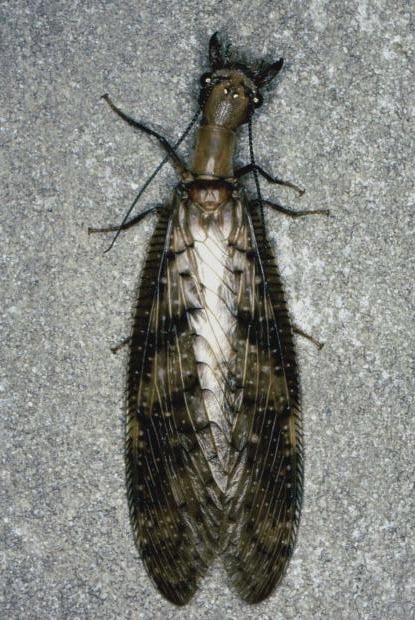#dobsonfly
Note
I must not fear. Fear is the mind-killer. Fear is the little-death that brings total obliteration. I will face my fear. I will permit it to pass over me and through me. And when it has gone past, I will turn the inner eye to see its path. Where the fear has gone there will be nothing. Only I will remain.
String identified:
t t a. a t -. a t tt-at tat g tta tat. ac a. t t t a a tg . A t a g at, t t t t at. t a a g t tg. a.
Closest match: Neoneuromus ignobilis isolate Gutianshan chromosome 3
Common name: Dobsonfly
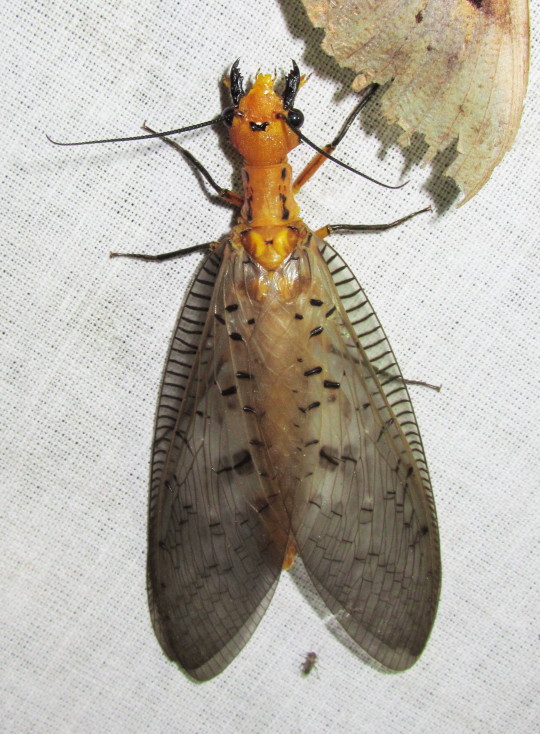
2K notes
·
View notes
Text
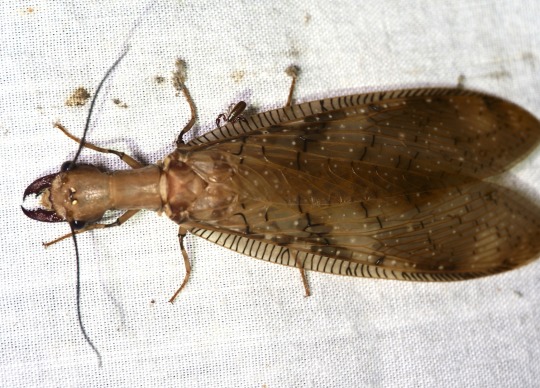

A dobsonfly and her little pseudoscorpion buddy.
1K notes
·
View notes
Text
Bug of the Day

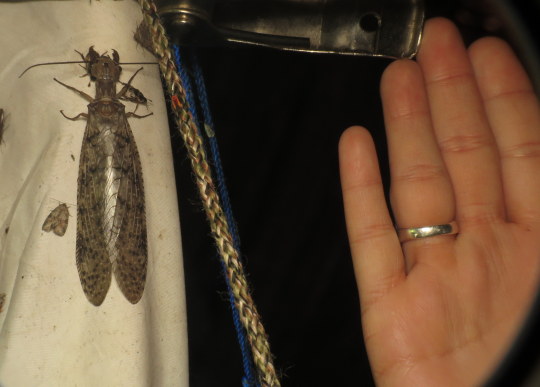
Ok, there were lots of votes for fuzzy (tomorrow, I promise), but I was inspired by @cccshutdown requesting "bring me the Longest beast you know" to post this ginormous female dobsonfly we found at the lights a couple of weeks ago. She is Eastern Dobsonfly (Corydalus cornutus), she is Megaloptera, and she is FIERCE!!
#Eastern dobsonfly#Corydalus cornutus#Corydalus#Corydalidae#dobsonfly#Megaloptera#insect#FIERCE#bug of the day#BotD
540 notes
·
View notes
Text
Wet Beast Wednesday: aquatic insect larvae
This Wet Beast Wednesday is going to be different than usual. Instead of an in-depth overview of a specific species or group of species, I'm going to give a general overview of aquatic insect larvae as a whole and then showcase some groups of insects. I'm going to focus on insects that have an aquatic larval stage and terrestrial adult stage, saving adult aquatic insects for another post.
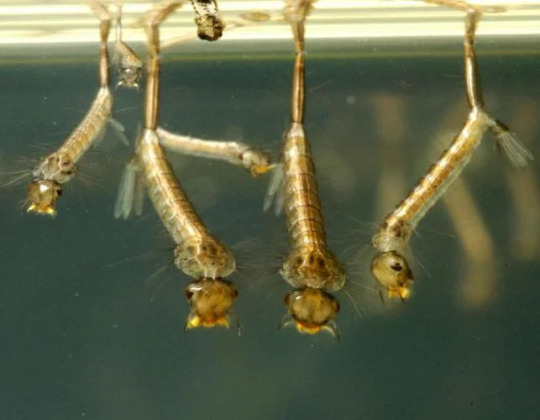
(Image ID: a group of mosquito larvae. They are yellowish bugs with long, slender bodies, no visible limbs, small heads, and feathery appendages from their rear ends. From the back of the abdomen, a snorkel-like appeadage attaches to the surface of the water, using surface tension to allow the larvae to hang from the surface. End ID)
Insects are basically the most successful group of animals in the history of life on Earth and have adapted to live in just about every terrestrial habitat. It should not be much of a surprise than that they have also moved into the water. More specifically, fresh water as almost all aquatic insects inhabit fresh or maybe brackish water. Only the water strider genus Halobates are truly marine. Some species of insect are aquatic for their entire lives, some are primarily terrestrial but able to swim, and some are aquatic only for their larval stage of life. These aquatic larvae species are generally agreed to have evolved from fully terrestrial ancestors. The adaptation of partially returning to the water has evolved independently many times in many different clades of insect and so different species use different strategies and adaptations. It is possible that aquatic larvae evolved in response to high competition for resources on land. If multiple species are competing over the same resources during their larval stages but one of those species manages to adapt to a whole new environment, that species will now have abundant access to resources the other species are unable to get to. Because of the very different lifestyles required for aquatic and terrestrial animals, aquatic larvae often look very different than their adult forms.
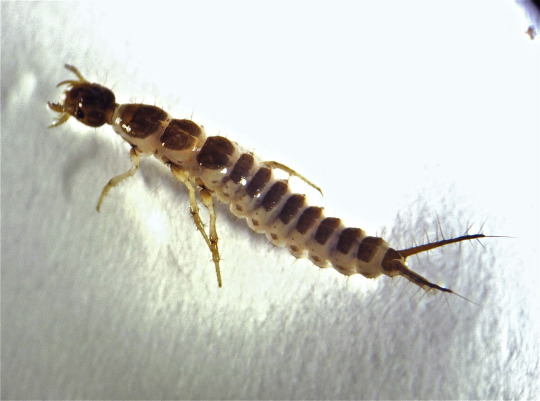
(Image: an aquatic beetle larva. It looks nothing like an adult beetle, instead being a long, slender insect with no wings, multiple body segments, and two hairy appendages at the base of the abdomen. End ID)
Aquatic larvae serve important roles in their ecosystems. Many are herbivores or detritivores that consume algae and bits of biological material, helping recycle nutrients and clean the water. Some are predators that hunt smaller invertebrates or plankton. Importantly, aquatic insect larvae provide a major food source for larger fish, invertebrates, birds, and so on. Some species can be considered keystone species, vital to their ecosystems. Many species are highly sensitive to changes in their environment, allowing them to act as indicator species for the health of their ecosystems. The trio of mayflies, stoneflies, and caddisflies are very commonly used as indicators of pollution as all three are highly sensitive to pollutants. A stream with few mayflies, stoneflies, or caddisflies but plenty of less sensitive species is likely to be polluted.
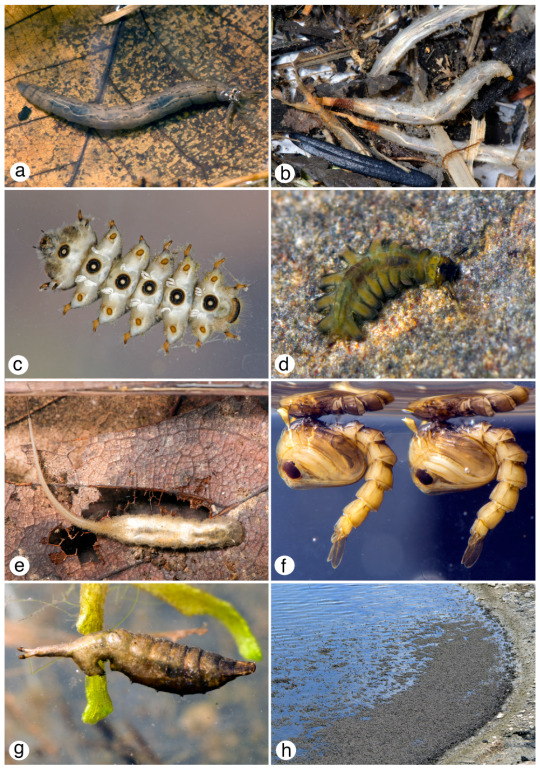
(Image ID: a collage of aquatic larvae of multiple species in the order Diptera (true flies. They vary from slug-like to having multiple distinct body segments with legs, to looking like maggots with long tails. End ID. Source)
Mayflies (order Ephemeroptera) are among the oldest lineages of winged insects, bearing traits that they first flying insect also had. Juvenile mayflies are technically not larvae, but nymphs. The difference between a larva and a nymph is that nymphs look much more like the adult stage than larvae do. Mayfly nymphs lack the wings of adults, but have external gills growing from the sides of their abdomens. Mayfly nymphs can be identified by three appendages called cerci that emerge from the back of the abdomen. They are bottom-dwellers that typically live under rocks and other objects or amid plants. Most are herbivores, feeding mainly on algae. Months to years after hatching (species dependent), mayflies will float to the surface and go through a molt to a stage called the subimago. Uniquely among insects, mayflies go through two final winged molts. The first is to a not sexually mature stage called the subimago, then they quickly molt again into a fully mature imago stage. These molts happen in sync, resulting in hundreds to thousands of mayflies appearing all at once and swarming together to mate. Famously, adult mayflies exist only to mate and die. Their digestive systems are non-functional and few species last past a few days.

(Image: a mayfly nymph on a rock. It is a yellow bug with no wings, a long abdomen, and thick, grasping legs. Three long, hairy cerci emerge from the back. Along the side of the abdomen are multiple pairs of white, feathery gills. End ID)
Stoneflies (order Plecoptera) also have nymphs and can be quite difficult to tell apart from mayfly nymphs if you don't know what to look for. One of the biggest differences is that their gills are located by the base of the legs rather than along the abdomen. Like mayflies, stoneflies are some of the most primitive winged insects, but mayflies are Paleopterans (the earliest wings insects) while stoneflies and most other winged insects are Neopterans. The main difference is that Neopterans can flex their wings over their abdomens while Paleopterans cannot, and must hold their wings either out to the side or up in the air. Like with Mayflies, many adult stoneflies have nonfunctional digestive systems and exist only to mate and die.

(Image: a stonefly larva. It looks similar to a mayfly larva, but has a shorter abdomen, gills along the base of the legs, and only two cerci. End ID)
Caddisflies (order tricoptera) are the builders of the aquatic insect world. These larvae (most species anyway) can produce silk from glands near their mouths. These are used to make a variety of structures made from silk and various other materials including sand, silt, plant parts, shells, rock, and so on. Different species will seek out specific materials for their structures. There are a few types of structures, the most common of which is a tubular case that is open at both ends. The larva can carry the case with it as it crawls around and can retreat into the case for protection. The larva can draw water into one end of the case and out the other, allowing oxygenated water to flow over the gills. By moving around in the case, the larva can draw in more water. This allows the larvae to survive in water that is too oxygen-poor for other larvae. Other species build different structures including turtle-shell like domes or stationary retreats. My favorite structures are nets built with an open end into current. The current naturally brings detritus and micro-invertebrates into the net, where the larva can eat them. Caddisflies also pupate into pupa that have mandibles to cut their way out of their cases and swimming legs. Once developed, the pupae swim to the surface and molt into their adult forms. This molting is synchronized to ensure the adults emerge in swarms and can easily find mates.
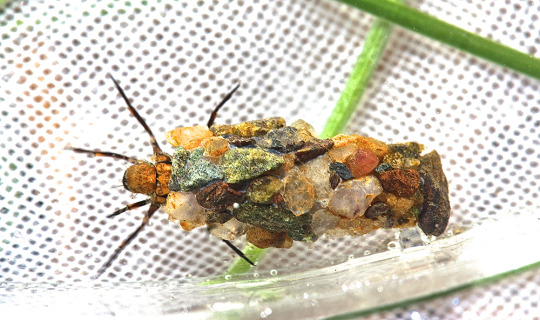
(Image ID: a caddisfly larva in its case. The case is a tube composed of pebbles of different colors stuck together with silk. The head and legs of the larva are merging from the front of the case. End ID)
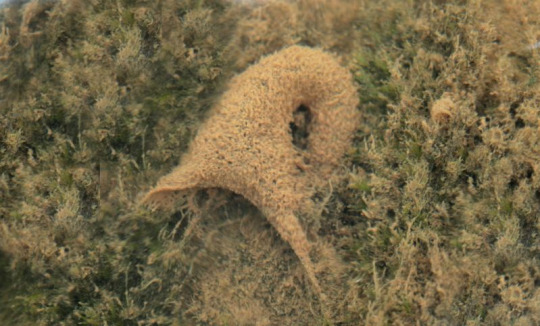
(Image: a caddisfly net. It is a structure made of silk shaped like a tube that is wide at one end and tapers toward the other. It is curved so both ends face the same way. End ID)
The order Megaloptera consists of alderflies, dobsonflies, and fishflies. All three have aquatic larvae, but their eggs are laid on land. Most species lad their eggs on plants overhanging the water so the larvae fall in once hatched, though a few lay eggs near the water's edge, forcing the larvae to crawl in. Meglaoptera have the least amount of differences between larva and adult of all holometabolous (pupa-forming) insects. The largest differences between the larvae and adults is the larvae lack wings and some species have leg-like prolegs. All species are carnivorous as larvae and feed on other invertebrates.
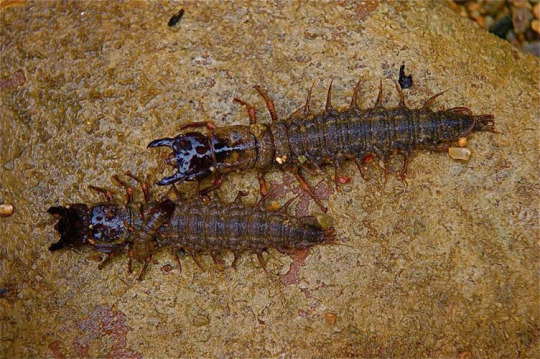
The adults don't look any less creepy
(Image: two hellgrammites, the larval form of a dobsonfly. It looks somewhat like a centipede with three pairs of limbs and a long abdomen with multiple pairs of leg-like prolegs. The head has no visible antennae, but does have a pair of powerful pincers. End ID)
Order Odonata consists of dragonflies and damselflies. These are powerful predators both as nymphs and adults. As nymphs, the juveniles are shorter and stockier than the adults, with no wings. The nymphs (or naiads) breathe through gills. In damselflies, these gills can be external, but dragonfly nymphs have their gills located in the anus. Damselflies can swim by undulating their gills, but dragonfly nymphs are restricted to crawling. The nymphs are voracious predators that will feed on anything they can catch. Most of their diet consists of invertebrates, but they will also attack small fish, tadpoles, and even salamanders.
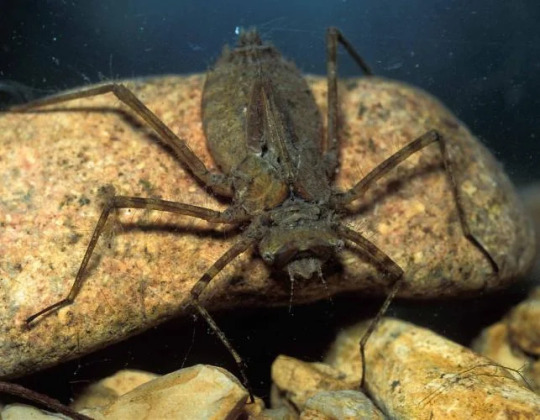
(Image ID: a dragonfly larva on a rock. Its head is similar to that of the adults, but the abdomen is much shorter and broader and the legs are longer. It has no wings and is brown all over. End ID)
The groups of insects I covered today (plus the stoneflies) all have exclusively or near-exclusively have aquatic larvae while the adults are terrestrial. In other groups, aquatic larvae may be present in some species while others have terrestrial larvae. For example, a great many members of the order Diptera (true flies) have aquatic larvae including all mosquitos, while other members of the order have fully terrestrial larvae. In addition there are species of beetle (order Coleoptera), moth (order Lepidoptera), lacewing (order Neuroptera), and scorpionflies (order Mecoptera) that have aquatic larvae and some species of the true bugs (order Hemiptera) have aquatic larvae and aquatic adults, including water skaters, water scorpions, and giant water bugs. Aquatic insects are so prevalent that it is rare to find any lasting body of water that doesn't host some aquatic larvae or adults. Even incredibly stagnant and filthy water can host aquatic insect larvae, as shown by the notorious rat-tailed maggots, who love stagnant water and breathe through snorkels. Many species require very specific conditions and there are species of insect who exclusively grow their larvae in specific streams or lakes. Because of this, conservation of these bodies of water is vital to their survival and pollution, damming, and other factors can destroy whole species.
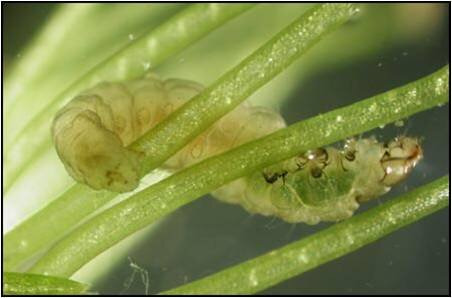
(Image: an aquatic moth larva. It looks very similar to a green land caterpillar, with none of the fancy elements many land species have. It is translucent and wrapped around some aquatic plant stems. End ID)
#wet beast wednesday#insects#insect larvae#aquatic insect larvae#larva#pupa#mayfly#stonefly#caddisfly#dobsonfly#hellgrammite#dragonfly#damselfly#freshwater ecology#ecology#biology#zoology#invertebrate#invertebrates#animal facts#informative#bug#bugs
35 notes
·
View notes
Text

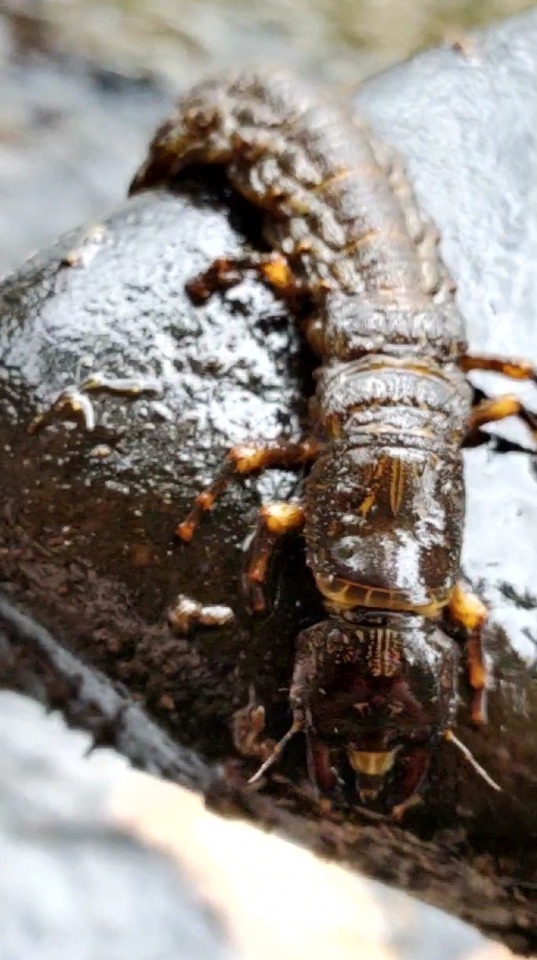
Eastern dobsonfly (Corydalus cornutus) larva I found while hanging out in the river in Northeastern Pennsylvania (US) last year.
Dobsonfly larvae, also known as hellgrammites, are one of the top invertebrate predators in fast-moving streams. They tend to hide under rocks and use their sharp mandibles to capture and eat prey. These mandibles can also deliver a painful (but harmless) bite, so definitely be careful handling them!
Larvae can get up to 3.5 inches (9 cm) long. Since they're large and relatively common, many of the local fishermen like to use them as bait (which may or may not be problematic).
These insects spend 1-3 years as larvae and pupate outside of the stream under a rock or log. The adults are huge. The male can be up to 5.5 inches (14 cm) long and has massive mandibles that are intimidating but harmless. Adults aren't known to feed, and they only live for about a week, just enough time to mate and lay eggs.
#dobsonfly#dobsonfly larva#hellgrammite#bug#Corydalus cornutus#Corydalidae#Megaloptera#eastern dobsonfly#nature#bugs#biodiversity#animals#inaturalist#arthropods#bugblr#entomology#insect appreciation#creature#invertebrates#aquatic life#pennsylvania#river#predator#nature appreciation#cool facts#biology#science#interesting
18 notes
·
View notes
Note
Look at this very cool bug I saw this morning!! It was HUGE.

OH!!!! Dobson fly!!! One of my favorites!!! He's beautiful and I'm very jealous you got to see him, but thank you very much for sharing him with me!
Sark saw a female one outside and sent me a photo but by the time I got out there to see it, she was gone :( they're so pretty, look at those beautiful wings!!
47 notes
·
View notes
Text
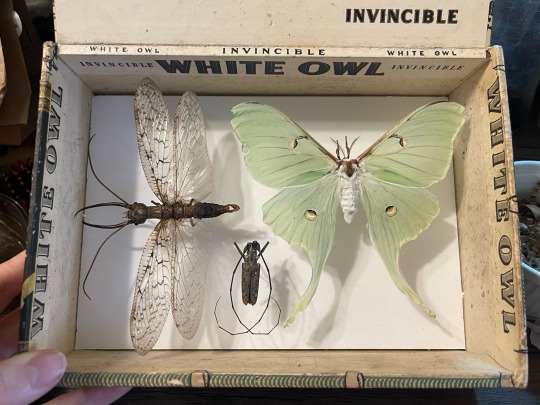
recent pins. still reconstructing the longhorn, he needs some legs glued on.
Eastern Dobsonfly, Corydalus cornutus
Northeastern Pine Sawyer, Monochamus notatus
Luna Moth, Actias luna
37 notes
·
View notes
Text
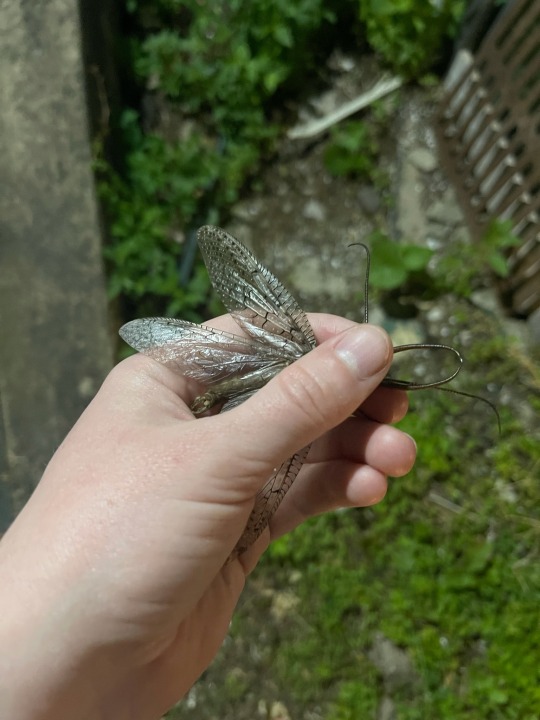


first bigman of the year, was loitering outside my front door
Corydalus cornutus
169 notes
·
View notes
Text

first artfight attack of 2022! it's @vyscera's dobsonfly girl! buying fruit!
122 notes
·
View notes
Text

A hellgrammite, the larval form of a dobsonfly (Corydalinae sp.)
by Bam Boozelled
31 notes
·
View notes
Text

it's her adventure backpack :T
from this study done to measure daily movements of dobsonfly larvae (hellgrammites!) in the genus neohermes. turns out they BARELY get around, never during the day and only sometimes at night. makes sense for ambush predators.
this study also believes it to be the first to use radio telemetry on insects, is that true??
3 notes
·
View notes
Note
Long before time had a name, Ninjago was created by the First Spinjitzu Master, using the Four Weapons of Spinjitzu. The Scythe of Quakes, the Nunchucks of Lightning, the Shurikens of Ice and the Sword of Fire. Weapons so powerful, no one can handle all of their power at once! When he passed away, his two sons swore to protect them, but the oldest was consumed by darkness and wanted to possess them. A battle between brothers broke out, and the oldest was struck down and banished to the Underworld. Peace returned, and the younger brother hid the weapons, but knowing his older brother's relentless ambition for power, he placed a guardian to protect them. And for fear of his own demise, a map for an honest man to hide. That honest man was your father. The older brother is Lord Garmadon, and I... need to find those weapons before he does.
String identified:
g t a a a, ag a cat t t t at, g t a t. T ct a, t cc gtg, t c a t . a , ca a a t at c! a aa, t t tct t, t t t a c a a at t t. A att t t t, a t t a tc a a t t . ac t, a t g t t a, t g t' t at , ac a gaa t tct t. A a , a a a t a t . Tat t a a at. T t Gaa, a … t t a .
Closest match: Neoneuromus ignobilis isolate Gutianshan chromosome 5
Common name: Dobsonfly

#tumblr genetics#genetics#ninjago#bugs#insects#flies#asks#requests#sent to me#caves-is-momentarilydisabled#dobsonfly#RETURN OF THE KING
1K notes
·
View notes
Text



@schrodingers-cate submitted: Hi again, from [removed] (remove please)! Heres another lovely set of bugs ive been collecting pictures of. Im really interested in the ID for these, ESPECIALLY the really large larva . He was so big i spotted him from a second story window of the house next to the driveway he was crawling on. If it helps, that larva was right next to a small creek on a rainy day. Thanks so much!!
Great group of weird pals! The beetle is an oak timberworm weevil and the green fellow looks like a crane fly in the genus Erioptera, mayyyyybe Erioptera chloroplylla. The big larva is a dobsonfly! They’re aquatic as larvae, but leave the water to pupate :)
#animals#insects#bugs#submission#beetle#weevile#oak timberworm weevil#fly#diptera#crane fly#Erioptera#Erioptera chlorophylla#dobsonfly#eastern dobsonfly#larva
85 notes
·
View notes
Text


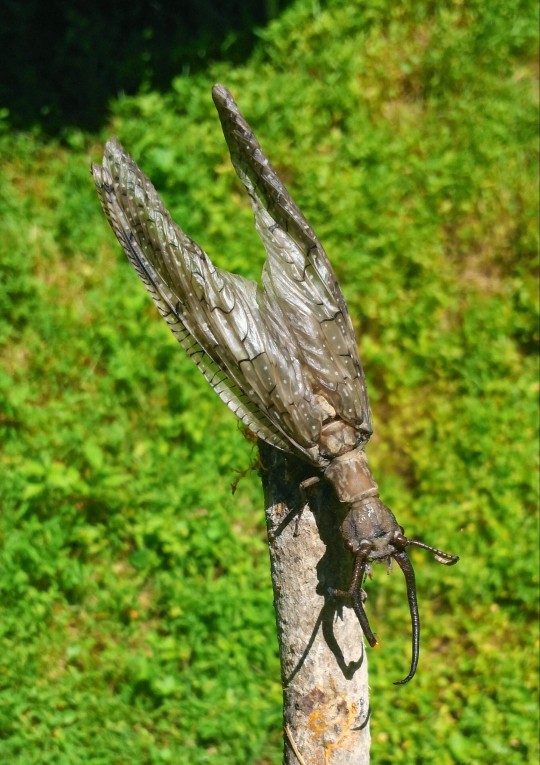
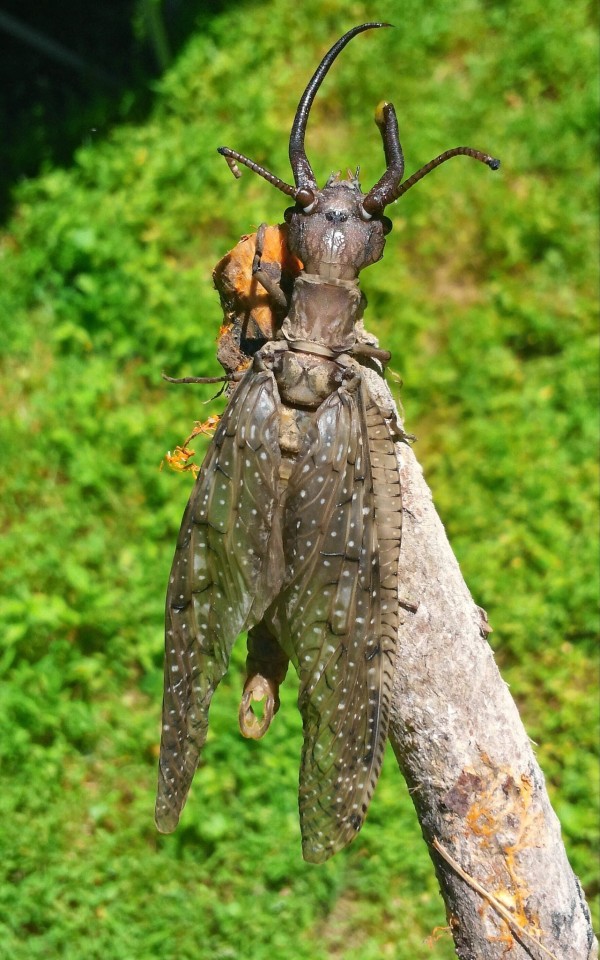
Found the rest of the photos for the Dobson Fly, he'd been a bit beat up when I found him.
#bolitoth blogs#bugs#insects#bug#bug core#bugblr#insect#invertebrate#dobson fly#dobsonfly#nature hikes#camping#camp here and there#natural#nature#adventuring#adventure#exploring#explore#entomology#camp#walkingaround#naturist#naturecore#trending#toptags#tw insects#cw bugs#bugs tw#entemology
68 notes
·
View notes
Link
9 notes
·
View notes
